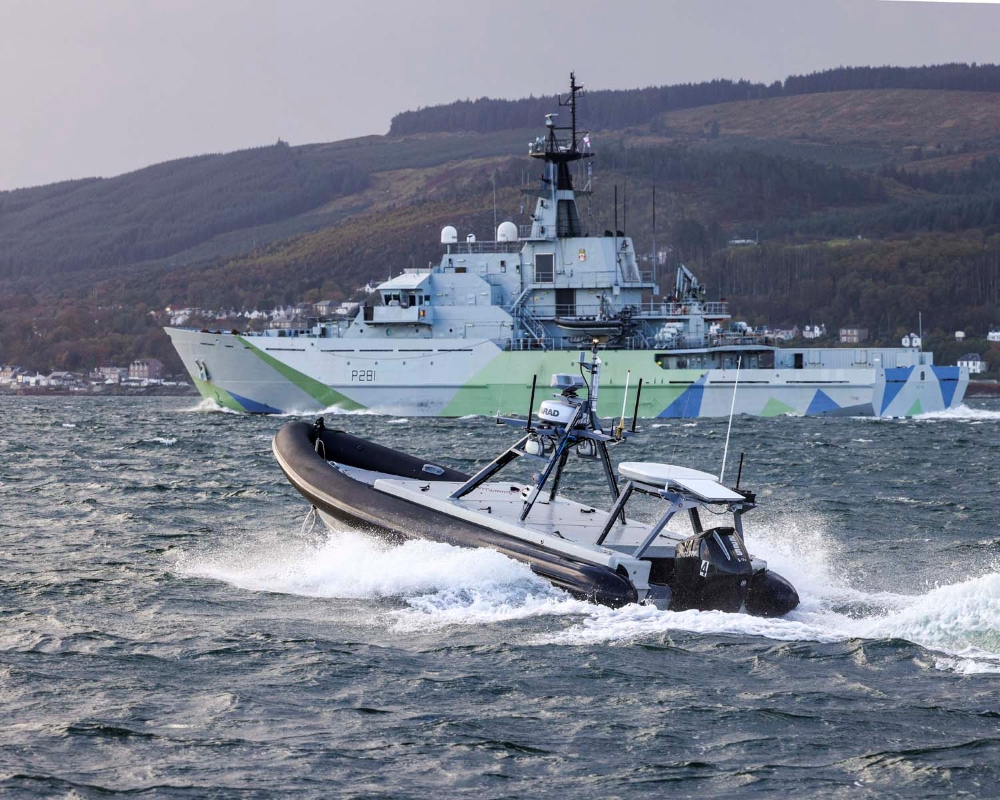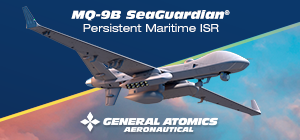
In the “last few months”, the Royal Navy has acquired at least 7 purpose-designed, 7.2 meters Uncrewed Surface Vehicles, named RATTLER, to continue its experimentation and capability development.
In the latest of a series of key trials, 5 RATTLERs manoeuvred at sea in Scottish waters alongside crewed vessels while controlled from over 500 miles away, through consoles embarked on the experimental testbed ship XV PATRICK BLACKETT.
The demonstration saw the USVs work with the P2000-class patrol boat HMS BITER of the Coastal Forces Squadron, a MERLIN helicopter, the patrol vessel HMS TYNE (RIVER Batch 1 class) and the mine-countermeasures support “mothership” HMS STIRLING CASTLE.
The RATTLERs successfully demonstrated interception and escorting of TYNE and STIRLING CASTLE as they played the role of passing foreign warships. The USVs sent cameras feed and data from “other sensors” all the way back to PATRICK BLACKETT.
The RATTLER, developed “in weeks” and procured rapidly and iteratively, is the first USV that the Royal Navy procures which is fully crewless by design, from the start. So far, all USVs were born out of manned platforms (for example, the Autonomous-PAC-24 RHIB by BAE Systems) and/or retain a cockpit for manual control where needed (the ARCIMS and L3ASV motor boats used for SWEEP and MMCM systems respectively within the Mine Hunting Capability MHC systems).
Working alongside a consortium of SMEs, military personnel helped design, build, test and develop the USVs, which is based on a rigid inflatable boat (RIB) hull fitted with autonomy packages and “a variety of other systems and services”. They can be pre-programmed with mission profiles, navigational routes and can work together as a ‘wolf pack’ on operations. In time they will be able to operate without direct human control.
Technically, autonomous operations with remote control are known as “Autonomy Level 3”, with Level 4 being full autonomy. So far, RATTLERs are operated by a crew of 2: one responsible for piloting the drone, the other monitoring and operating the onboard systems and assisting to manage the live data streams. The entire setup is fully portable, run via a “plug and play” laptop configuration, allowing easy, flexible and full operation from various fixed and mobile locations.
The USVs were initially operated, without fanfare, out of Portsmouth and Portland, and in the busy seaways of the Solent.
This is yet another step forward in an ongoing program of development and trials which has also seen the Royal Navy recently operate with the Kraken K3 scout USV. The Navy has gone through a long campaign of trials in order to certificate earlier the already mentioned APAC-24 and the MHC USVs for Degree 3 autonomy and above.
The XV PATRICK BLACKETT, which served in this case as remote, afloat command post, is expected to play a key role in demonstrating Autonomy Level 4 on the way to large Uncrewed warships. At circa 40 meters, PATRICK BLACKETT is, not by chance, the size of the “Medium USV” the Royal Navy has already been asking industry for proposals about in terms of ASW and MCM sensor packages.
PATRICK BLACKETT could lead, more or less directly, to the intended Type 92 uncrewed “sloop” to be acquired in the future, with projects for larger and more ambitious optionally crewed/uncrewed ships 90 or more meters long having been mentioned by the First Sea Lord.








.png)
